Microgravity


Microgravity
NASA ID: 9515855
Date Created: 1995-10-20
Onboard STS-73, USML-2: Mission Specialist, Payload Commander, Kathryn Thorton with (CGF) Crystal Growth Furnace
Witch Head Nebula
Image Credit: NASA/STScI Digitized Sky Survey/Noel Carboni
As the name implies, this reflection nebula associated with the star Rigel looks suspiciously like a fairytale crone. Formally known as IC 2118 in the constellation Orion, the Witch Head Nebula glows primarily by light reflected from the star. The color of this very blue nebula is caused not only by blue color of its star, but also because the dust grains reflect blue light more efficiently than red. A similar physical process causes Earth's daytime sky to appear blue.
More Posts from Womeninspaceexploration and Others


Chawla prepares the CM for installation of MIST in the SH during STS-107
STS-107 Mission Specialist 2 MS Kalpana 'KC' Chawla reads a checklist in the Spacehab SH Research Double Module RDM as she prepares the Combustion Module CM-2 for installation of the Water Mist Fire Suppression Experiment MIST.
Kalpana Chawla
(March 17, 1962 – February 1, 2003) was an American astronaut, engineer, and the first female of Indian origin to go to space. She first flew on Space Shuttle Columbia in 1997 as a mission specialist and primary robotic arm operator. In 2003, Chawla was one of the seven crew members who died in the Space Shuttle Columbia disaster when the spacecraft disintegrated during its re-entry into the Earth's atmosphere. Chawla was posthumously awarded the Congressional Space Medal of Honor, and several streets, universities and institutions have been named in her honor.
Hubble Looks Into a Cosmic Kaleidoscope
At first glance, this cosmic kaleidoscope of purple, blue and pink offers a strikingly beautiful — and serene — snapshot of the cosmos. However, this multi-colored haze actually marks the site of two colliding galaxy clusters, forming a single object known as MACS J0416.1-2403 (or MACS J0416 for short).
MACS J0416 is located about 4.3 billion light-years from Earth, in the constellation of Eridanus. This image of the cluster combines data from three different telescopes: the NASA/ESA Hubble Space Telescope (showing the galaxies and stars), the NASA Chandra X-ray Observatory (diffuse emission in blue), and the NRAO Jansky Very Large Array (diffuse emission in pink). Each telescope shows a different element of the cluster, allowing astronomers to study MACS J0416 in detail.
As with all galaxy clusters, MACS J0416 contains a significant amount of dark matter, which leaves a detectable imprint in visible light by distorting the images of background galaxies. In this image, this dark matter appears to align well with the blue-hued hot gas, suggesting that the two clusters have not yet collided; if the clusters had already smashed into one another, the dark matter and gas would have separated. MACS J0416 also contains other features — such as a compact core of hot gas — that would likely have been disrupted had a collision already occurred.
Together with five other galaxy clusters, MACS J0416 is playing a leading role in the Hubble Frontier Fields program, for which this data was obtained. Owing to its huge mass, the cluster is in fact bending the light of background objects, acting as a magnifying lens. Astronomers can use this phenomenon to find galaxies that existed only hundreds of million years after the big bang.
For more information on both Frontier Fields and the phenomenon of gravitational lensing, see Hubblecast 90: The final frontier.
Text credit: European Space Agency Image credit: NASA, ESA, CXC, NRAO/AUI/NSF, STScI, and G. Ogrean (Stanford University), Acknowledgment: NASA, ESA, and J. Lotz (STScI), and the HFF team


Materials Science Experiments Conducted at MSFC
In another first for NASA, an all-female crew of scientific experimenters began a five-day exercise on December 16, 1974, to test the feasibility of experiments that were later tested on the Space Shuttle/Spacelab missions. The experimenters, Dr. Mary H. Johnston (seated, left), Ann F. Whitaker and Carolyn S. Griner (standing, left to right), and the crew chief, Doris Chandler, spent spend eight hours each day of the mission in the Marshall Space Flight Centers General Purpose Laboratory (GPL). They conducted 11 selected experiments in materials science to determine their practical application for Spacelab missions and to identify integration and operational problems that might occur on actual missions.
Image # :565782
Date: November 13, 1974
N81 in the Small Magellanic Cloud
A NASA Hubble Space Telescope "family portrait" of young, ultra-bright stars nested in their embryonic cloud of glowing gases. The celestial maternity ward, called N81, is located 200,000 light-years away in the Small Magellanic Cloud (SMC), a small irregular satellite galaxy of our Milky Way. Hubble's exquisite resolution allows astronomers to pinpoint 50 separate stars tightly packed in the nebula's core within a 10 light- year diameter - slightly more than twice the distance between earth and the nearest star to our sun. The closest pair of stars is only 1/3 of a light-year apart (0.3 arcseconds in the sky). This furious rate of mass loss from these super-hot stars is evident in the Hubble picture that reveals dramatic shapes sculpted in the nebula's wall of glowing gases by violent stellar winds and shock waves. A pair of bright stars in the center of the nebula is pouring out most of the ultraviolet radiation to make the nebula glow. Just above them, a small dark knot is all that is left of the cold cloud of molecular hydrogen and dust the stars were born from. Dark absorption lanes of residual dust trisect the nebula. The nebula offers a unique opportunity for a close-up glimpse at the firestorm' accompanying the birth of extremely massive stars, each blazing with the brilliance of 300,000 of our suns. Such galactic fireworks were much more common billions of years ago in the early universe, when most star formation took place. The "natural- color" view was assembled from separate images taken with the Wide Field and Planetary Camera 2, in ultraviolet light and two narrow emission lines of ionized Hydrogen (H-alpha, H-beta).
Image # : PR98-25
Date: September 24, 1997
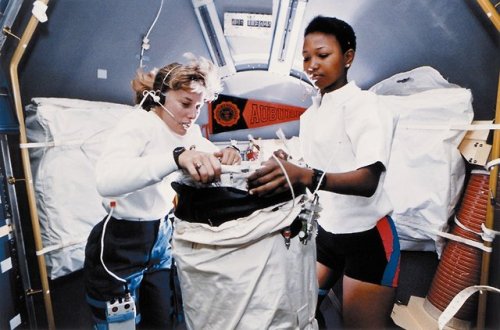
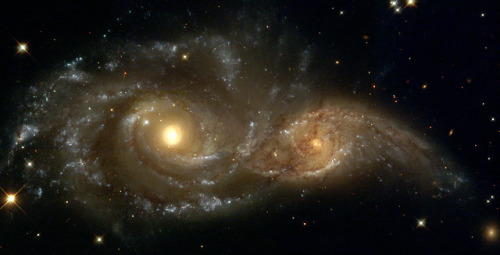
Astronauts Jan Davis & Mae Jemison on STS-47
Astronauts Dr. N. Jan Davis (left) and Dr. Mae C. Jemison (right) were mission specialists on board the STS-47 mission. The astronauts are shown preparing to deploy the lower body negative pressure (LBNP) apparatus in this 35mm frame taken in the science module aboard the Earth-orbiting Space Shuttle Endeavor.
Image # : 92-HC-641
Date: August 15, 1992
A Grazing Encounter Between Two Spiral Galaxies
The larger and more massive galaxy is cataloged as NGC 2207 (on the left in the Hubble Heritage image), and the smaller one on the right is IC 2163. Strong tidal forces from NGC 2207 have distorted the shape of IC 2163, flinging out stars and gas into long streamers stretching out a hundred thousand light-years toward the right-hand edge of the image. Computer simulations, carried out by a team led by Bruce and Debra Elmegreen, demonstrate the leisurely timescale over which galactic collisions occur. In addition to the Hubble images, measurements made with the National Science Foundation's Very Large Array Radio Telescope in New Mexico reveal the motions of the galaxies and aid the reconstruction of the collision.
Image # : PR99-41
Date: November 4, 1999
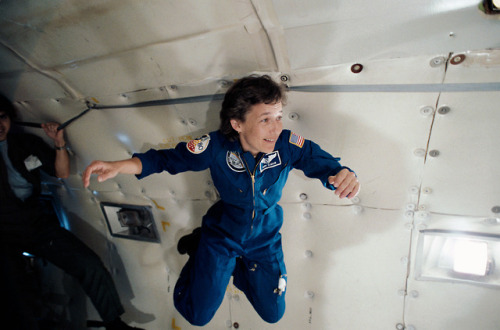
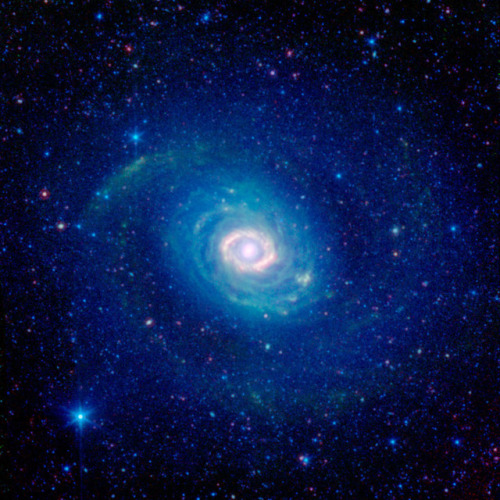
STS 61-B crewmembers training on the KC-135 in zero-G
NASA ID: S85-39137
Date Created: 1985-08-21
STS 61-B crewmembers training on the KC-135 in zero-G. Views include Payload specialist Charles D. Walker attempting to down the lower torso of his extravehicular mobility unit (EMU) in zero-G in the KC-135. He is being assisted by other participants in the training (39135); Payload specialist Rodolfo Neri floating in midair during training in the KC-135 (39136,39138); Mission specialist Mary L. Cleave floating in midair during her training aboard the KC-135 (39137); Astronaut Bryan D. O'Connor assists Astronaut Sherwood C. Spring in completing his donning of the EMU in the KC-135 (39139); Technicians aid Spring with his EMU in the KC-135 (39140); O'Connor appears to be leaping up in zero-G aboard the KC-135 (39141); Astronaut Brewster Shaw is assisted by a technician to don his EMU (39142); Shaw is attempting to don the EMU gloves while O'Connor watches (39143); Shaw does jumping jacks while Neri attempts to travel down a rope guideline (39144).
Galactic Wheels within Wheels
Mission: Spitzer Space Telescope
Instrument: Infrared Array Camera (IRAC)
Image credit: NASA/JPL-Caltech
MAY 16, 2013
How many rings do you see in this new image of the galaxy Messier 94, also known as NGC 4736? While at first glance one might see a number of them, astronomers believe there is just one. This image was captured in infrared light by NASA's Spitzer Space Telescope.
Historically, Messier 94 was considered to have two strikingly different rings: a brilliant, compact band encircling the galaxy's core, and a faint, broad, swath of stars falling outside its main disk.
Astronomers have recently discovered that the outer ring, seen here in the deep blue glow of starlight, might actually be more of an optical illusion. A 2009 study combined infrared Spitzer observations with those from other telescopes, including ultraviolet data from NASA's Galaxy Evolution Explorer, now operated by the California Institute of Technology, Pasadena; visible data from the Sloan Digital Sky Survey; and shorter-wavelength infrared light from the Two Micron All Sky Survey (2MASS). This more complete picture of Messier 94 indicates that we are really seeing two separate spiral arms, which, from our perspective, take on the appearance of a single, unbroken ring.
The bright inner ring of Messier 94 is very real, however. This area is sometimes identified as a "starburst ring" because of the frenetic pace of star formation in the confined area. Starbursts like this can often be triggered by gravitational encounters with other galaxies, but in this case might be caused by the galaxy's oval shape.
Tucked in between the inner starburst ring and the outer ring-like arms is the galaxy's disk, striated with greenish filaments of dust. While these dusty arcs look like a collection of rings, they actually follow tightly wound spiral arcs.
Infrared light with wavelengths of 3.6 and 4.5 microns is represented in blue/cyan, and primarily shows the glow from starlight. Light of 8 microns is rendered in green, and 24-micron emission is red, tracing the cooler and warmer components of dust, respectively. The image was taken in 2004, before Spitzer ran out of cryogen.
The 2MASS mission was a joint effort between the California Institute of Technology, Pasadena, Calif., the University of Massachusetts and NASA's Jet Propulsion Laboratory, Pasadena, Calif.
NASA's Jet Propulsion Laboratory, Pasadena, Calif., manages the Spitzer Space Telescope mission for NASA's Science Mission Directorate, Washington. Science operations are conducted at the Spitzer Science Center at the California Institute of Technology in Pasadena. Data are archived at the Infrared Science Archive housed at the Infrared Processing and Analysis Center at Caltech. Caltech manages JPL for NASA. For more information about Spitzer, visit http://spitzer.caltech.edu and http://www.nasa.gov/spitzer.

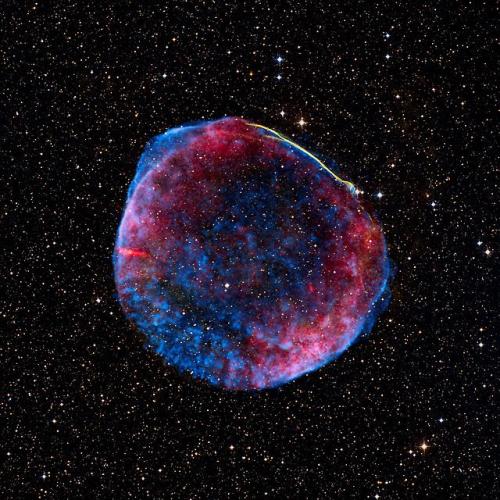
Sally K. Ride
Title: Sally K. Ride
Catalog #: WOF_00203
Additional Information: Astronaut
Item Location: Women of Flight Box 3
Collection: Women of Flight Special Collection
Tags: Women of Flight Photo, Sally K. Ride
Repository: San Diego Air and Space Museum Archive
Hubble Sees Stars and a Stripe in Celestial Fireworks
Creator: NASA Goddard
Date Created: 12/8/2017
NASA ID: GSFC_20171208_Archive_e002166
Release date: July 1, 2008 This image is a composite of visible (or optical), radio, and X-ray data of the full shell of the supernova remnant from SN 1006. The radio data show much of the extent that the X-ray image shows. In contrast, only a small linear filament in the northwest corner of the shell is visible in the optical data. The object has an angular size of roughly 30 arcminutes (0.5 degree, or about the size of the full moon), and a physical size of 60 light-years (18 parsecs) based on its distance of nearly 7,000 light-years. The small green box along the bright filament at the top of the image corresponds to the dimensions of the Hubble release image. The optical data was obtained at the University of Michigan's 0.9-meter Curtis Schmidt telescope at the National Science Foundation's Cerro Tololo Inter-American Observatory (CTIO) near La Serena, Chile. H-alpha, continuum-subtracted data were provided by F. Winkler (Middlebury COllege) et al. The X-ray data were acquired from the Chandra X-ray Observatory's AXAF CCD Imaging Spectrometer (ACIS) at 0.5-3keV, and were provided by J. Hughes (Rutgers University) et al. The radio data, supplied by K. Dyer (NRAO, Socorro) et al., were a composite from the National Radio Astronomy Observatory's Very Large Array (NRAO/VLA) in Socorro, New Mexico, along with the Green Bank Telescope (GBT) in Green Bank, West Virginia. Data of the supernova remnant were blended on a visible-light stellar background created using the Digitized Sky Survey's Anglo-Australian Observatory (AAO2) blue and red plates. Photo Credit: NASA, ESA, and Z. Levay (STScI) Science Credit: Radio: NRAO/AUI/NSF GBT+VLA 1.4 GHz mosaic (Dyer, Maddalena and Cornwell, NRAO); X-ray: NASA/CXC/Rutgers/G. Cassam-Chenai and J. Hughes et al.; Optical: F.Winkler/Middlebury College and NOAO/AURA/NSF; and DSS
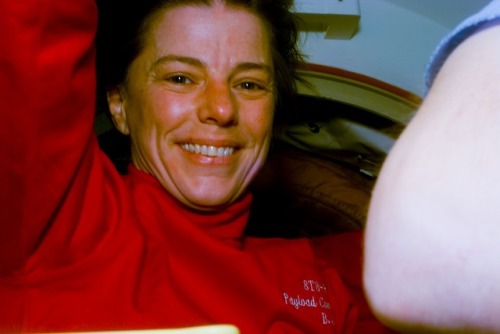
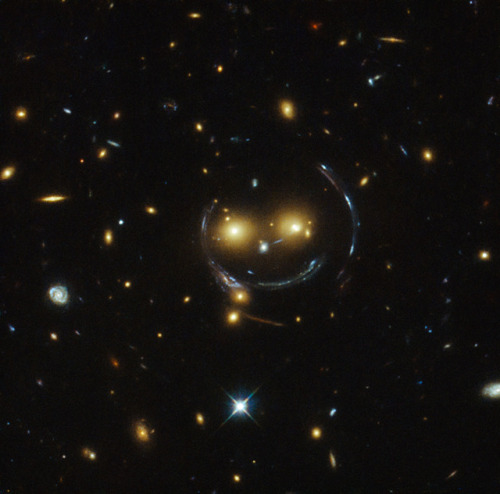
Scenes from the STS-89/Mir 24 welcome ceremony
NASA ID: s89e5175
Date Created: 1998-03-04
S89-E-5175 (24 Jan 1998) --- This Electronic Still Camera (ESC) image shows astronaut Bonnie J. Dunbar, payload commander, shortly after Shuttle/Mir docking activities began. "Deja-vu" may have come to the mind of Dunbar as she boarded Russia's Mir Space Station. Dunbar was a member of the STS-71 crew -- the first United States aggregation to visit Mir -- along with cosmonaut Anatoliy Y. Solovyev, Mir-24 commander. The ESC view was taken at 22:37:23 GMT, on January 24, 1998.
Hubble Sees A Smiling Lens
NASA ID: GSFC_20171208_Archive_e000791
Date Created: 12/8/2017
In the center of this image, taken with the NASA/ESA Hubble Space Telescope, is the galaxy cluster SDSS J1038+4849 — and it seems to be smiling. You can make out its two orange eyes and white button nose. In the case of this “happy face”, the two eyes are very bright galaxies and the misleading smile lines are actually arcs caused by an effect known as strong gravitational lensing. Galaxy clusters are the most massive structures in the Universe and exert such a powerful gravitational pull that they warp the spacetime around them and act as cosmic lenses which can magnify, distort and bend the light behind them. This phenomenon, crucial to many of Hubble’s discoveries, can be explained by Einstein’s theory of general relativity. In this special case of gravitational lensing, a ring — known as an Einstein Ring — is produced from this bending of light, a consequence of the exact and symmetrical alignment of the source, lens and observer and resulting in the ring-like structure we see here. Hubble has provided astronomers with the tools to probe these massive galaxies and model their lensing effects, allowing us to peer further into the early Universe than ever before. This object was studied by Hubble’s Wide Field and Planetary Camera 2 (WFPC2) and Wide Field Camera 3 (WFC3) as part of a survey of strong lenses. A version of this image was entered into the Hubble’s Hidden Treasures image processing competition by contestant Judy Schmidt. Image Credit: NASA/ESA
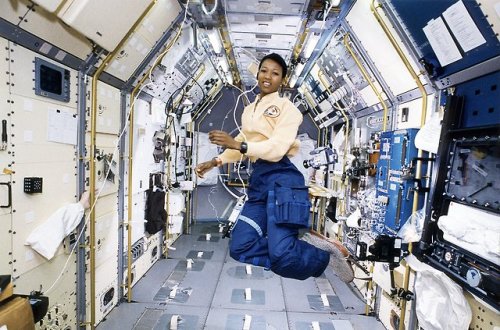
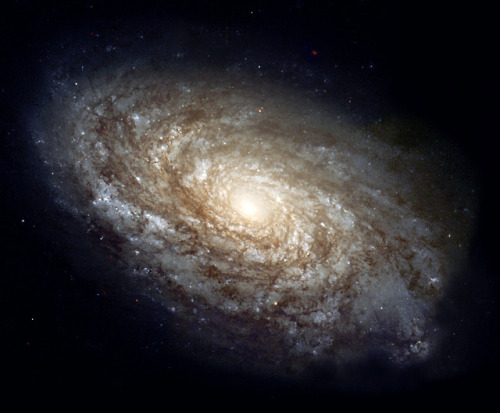
Astronaut Mae Jemison Working in Spacelab-J
Description (October 22, 1992) Space Shuttle Endeavour (STS-47) onboard photo of Astronaut Mae Jemison working in Spacelab-J module. Spacelab-J is a combined National Space Development Agency of Japan (NASDA) and NASA mission. The objectives included life sciences, microgravity and technology research.
Identifier: MSFC-9265609
Magnificant Details in a Dusty Spiral Galaxy
(June 3, 1999) In 1995, the majestic spiral galaxy NGC 4414 was imaged by the Hubble Space Telescope as part of the HST Key Project on the Extragalactic Distance Scale. An international team of astronomers, led by Dr. Wendy Freedman of the Observatories of the Carnegie Institution of Washington, observed this galaxy on 13 different occasions over the course of two months. Images were obtained with Hubble's Wide Field Planetary Camera 2 (WFPC2) through three different color filters. Based on their discovery and careful brightness measurements of variable stars in NGC 4414, the Key Project astronomers were able to make an accurate determination of the distance to the galaxy. The resulting distance to NGC 4414, 19.1 megaparsecs or about 60 million light-years, along with similarly determined distances to other nearby galaxies, contributes to astronomers' overall knowledge of the rate of expansion of the universe. In 1999, the Hubble Heritage Team revisited NGC 4414 and completed its portrait by observing the other half with the same filters as were used in 1995. The end result is a stunning full-color look at the entire dusty spiral galaxy. The new Hubble picture shows that the central regions of this galaxy, as is typical of most spirals, contain primarily older, yellow and red stars. The outer spiral arms are considerably bluer due to ongoing formation of young, blue stars, the brightest of which can be seen individually at the high resolution provided by the Hubble camera. The arms are also very rich in clouds of interstellar dust, seen as dark patches and streaks silhouetted against the starlight.
Image # : PR99-25

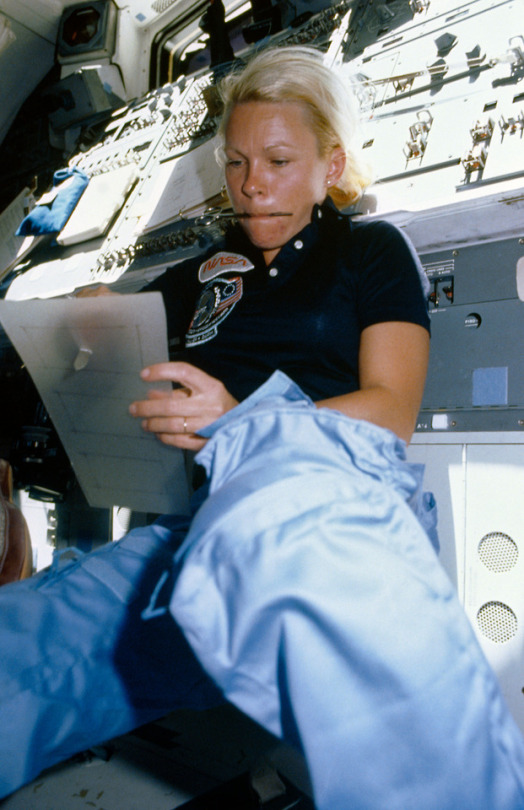
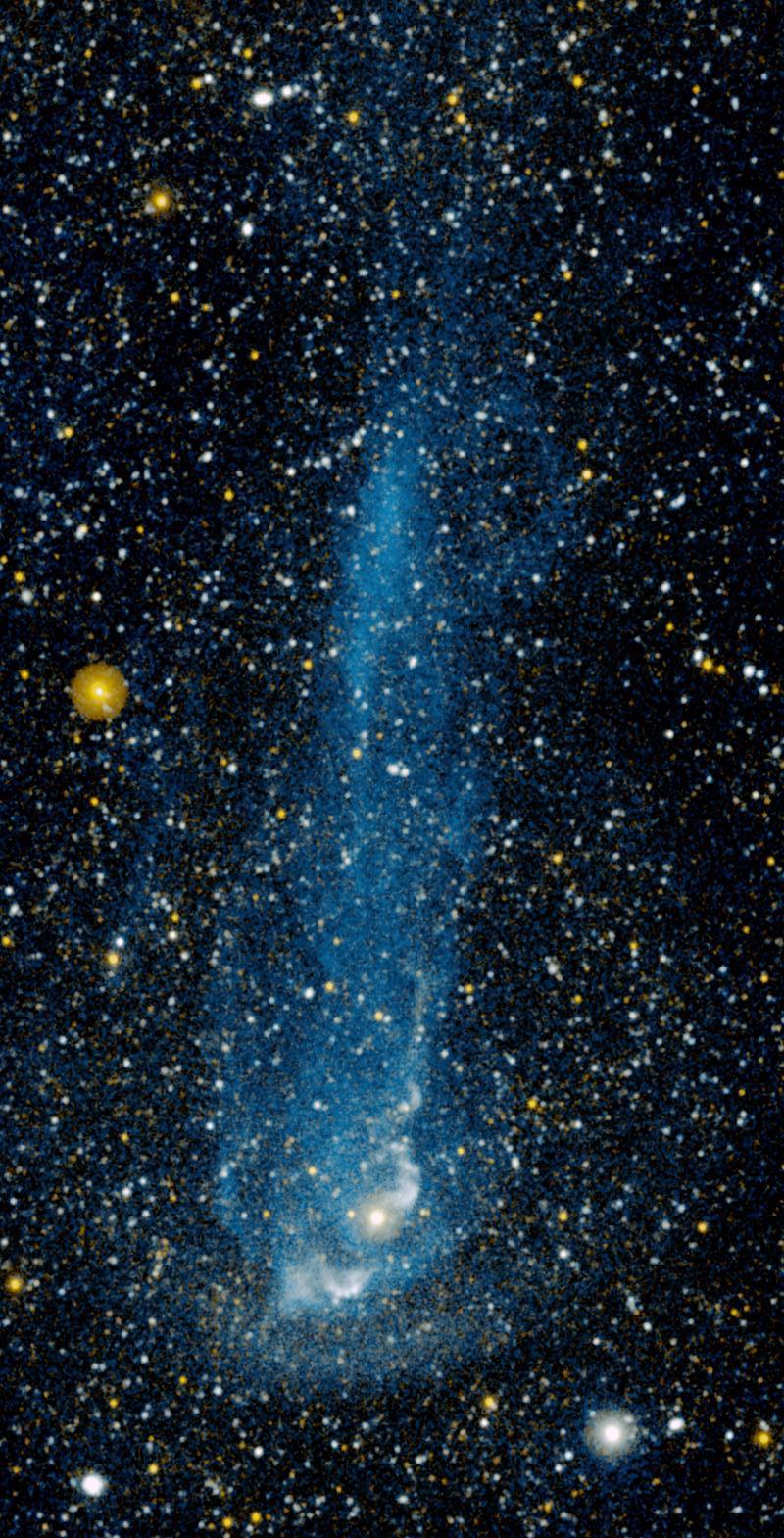
Astronaut Rhea Seddon works on flyswatter-like snagging device
NASA ID: 51d-07-003
Date Created: 1985-04-17
51D-07-003 (12-19 April 1985) --- Astronaut Rhea Seddon begins early work on a fly swatter-like snagging device to be used as an extension to the Remote Manipulator System (RMS) arm on Discovery for an April 17, 1985 attempt to trip a lever on the troubled Syncom-IV satellite.
Anatomy of a Shooting Star
NASA ID: PIA09959
Date Created: 2007-08-15
A close-up view of a star racing through space faster than a speeding bullet can be seen in this image from NASA Galaxy Evolution Explorer. The star is called Mira pronounced My-rah.
Tampons were packed with their strings connecting them, like a strip of sausages, so they wouldn’t float away. Engineers asked Ride, “Is 100 the right number?” She would be in space for a week. “That would not be the right number,” she told them. At every turn, her difference was made clear to her. When it was announced Ride had been named to a space flight mission, her shuttle commander, Bob Crippen, who became a lifelong friend and colleague, introduced her as “undoubtedly the prettiest member of the crew.” At another press event, a reporter asked Ride how she would react to a problem on the shuttle: “Do you weep?”
Astronaut Sally Ride and the Burden of Being “The First” (via dinosaurparty)
-
 womeninspaceexploration reblogged this · 6 years ago
womeninspaceexploration reblogged this · 6 years ago
